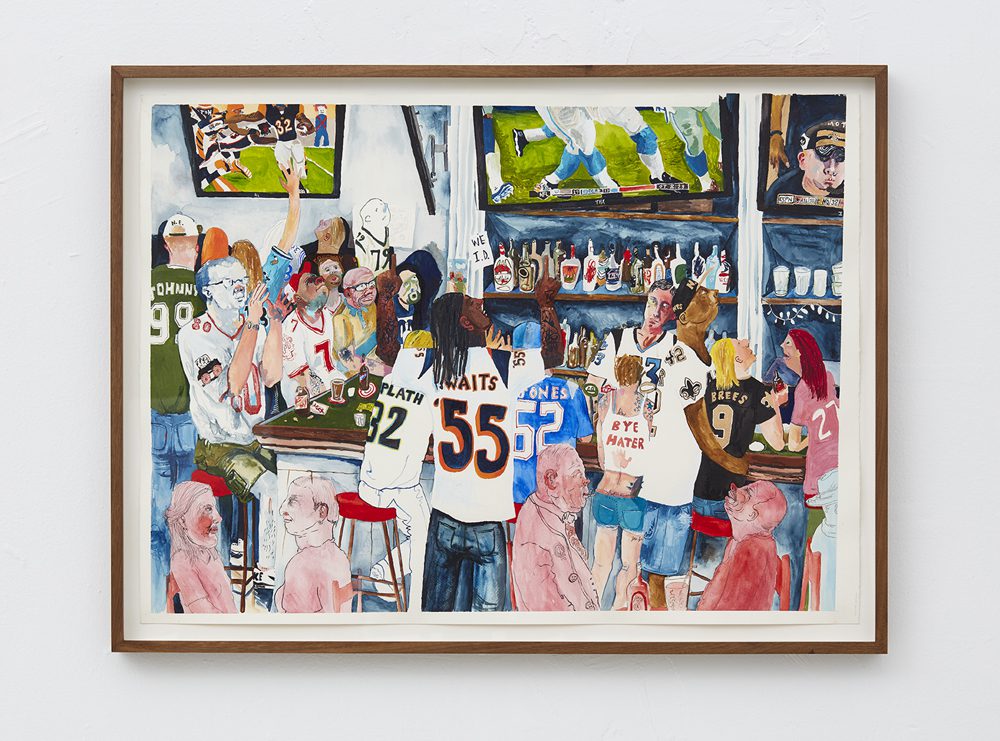American Myths: The Paintings of Celeste Dupuy-Spencer
Celeste Dupuy-Spencer’s paintings, currently featured in the 2017 Whitney Biennial, capture cultural divisions within the United States. Hyunjee Nicole Kim follows the artist’s moves in and out of the art world and around the country.

Celeste Dupuy-Spencer, It’s a Sports Bar But It Used To Be a Gay Bar, 2016. Watercolor and gouache on paper. Courtesy the artist and MIER Gallery, Los Angeles.
There’s a gap in the exhibition history of Celeste Dupuy-Spencer’s CV. In 2012, a family situation initially forced the painter to move from New York to New Orleans. The painter effectively “quit art” to live and work there until 2015. She had been frustrated with her own output and wanted to expunge the competition and myopia of the art world from her life. In New Orleans, she accepted a position to work as a caretaker at Bridge House and Grace House, long-term rehabilitation centers for those suffering from substance abuse, and she did not produce artwork in that period. Though she did not relocate to New Orleans to abandon painting, the time to reflect upon herself as an artist was much needed, and at the time she had no intention of picking it back up.
Now based in Los Angeles, Dupuy-Spencer spends the bulk of her days in a cozy studio where numerous works-in-progress are hung neatly on the white walls. The city’s reputation as a site of myth-making suits her paintings, “supernarratives” that often deftly snatch moments of contemporary rural life in thematically layered, figurative scenes. (Several examples of her work are currently on display in the 2017 Whitney Biennial.) When I visited her studio, we discussed our awkward appreciation for Americana, in its schmaltzy and unexpected variations, and how sentimentality can be accommodating of both sadness and humor—how the feeling’s vastness can be as slyly revealing as the shrewdest displays of irony.
Raised in Rhinebeck, New York, Dupuy-Spencer traces her family history back to both revolutionary Jewish communists in Chicago and rascally nobles who were banished from France to the swamps of Louisiana. She spent her youth shuttling between East Coast “country” and the Louisiana bayou. After studying at Bard College, Dupuy-Spencer then lived in Brooklyn for about ten years before heading south. Her mother had fled New Orleans for New York at the age of 17, grappling with an ambivalent relationship to her Southern heritage. As Dupuy-Spencer tried to navigate her own way through the South, she was increasingly disturbed by the cognitive dissonance between history and present: “Our relationship to that stuff is so twisted…It’s...desperately trying to be like, ‘that has nothing to do with me’—when in fact it has everything to do with you.” Dupuy-Spencer refused to attend a family member’s wedding, which was held at a plantation used as a location for filming director Steve McQueen’s 12 Years a Slave (2013).

Celeste Dupuy-Spencer, St. Tammany Parish, 2016. Oil on canvas. Courtesy the artist and MIER Gallery, Los Angeles.
Inspired by these thoughts from her stint in New Orleans, Dupuy-Spencer returned to painting with a renewed confidence and found her output “completely changed.” Her work can depict lively mise-en-scènes that could have been plucked from Renoir paintings—had he lived in the present—like My Brother Grilling Mushrooms Upstate, 2016, and elegant New Objectivity-inspired portraits, like Glassel Park, 2016. She also showed me a number of tidy, intimate landscape paintings based on drives she had taken through America’s winding highways that connect city and country. In the watercolor CigScape, 2015, a craggy rock formation is capped with the profile of a face and the ground is littered with cigarettes. The details that Dupuy-Spencer amplifies in her compositions highlight the quotidian and universal, yet reveal distinctions defined by geographical and cultural contexts.
Much ado has been made over the past few months regarding the sharp political and cultural divisions between the urban and rural areas of the United States, but it seems that actionable steps toward reconciliation and healing are still unknown. How do we, as a country, begin to reckon with America’s fraught history, undeniably tethered to the oft-ignored trauma of the transatlantic slave trade? After spending an extended period of time in Berlin last year, Dupuy-Spencer began to recognize the particularly American failure to contend with its horrific past and how deeply that legacy was intertwined with her Southern roots. She noted the moving way Germans had mounted “monument after monument of their failure” in the wake of World War II, attributing and acknowledging their complicity in propagating mass genocide. She laments that “we don’t get a chance to sift through this,” and instead ignore the crippling inheritance of slavery and racism in America while continuing to honor fallen Confederate soldiers. (Four Confederate monuments in New Orleans were recently removed after years of City Council hearings, court cases, and death threats.) Our complicity and repression fuels a poisonous narrative we would rather ignore and forget—one that will continue to metastasize across all American locales, whether New Orleans, Rhinebeck, or Los Angeles.
Editor's Note
The 2017 Whitney Biennial is on view through June 11, 2017, at the Whitney Museum of American Art (99 Gansevoort Street) in New York.



